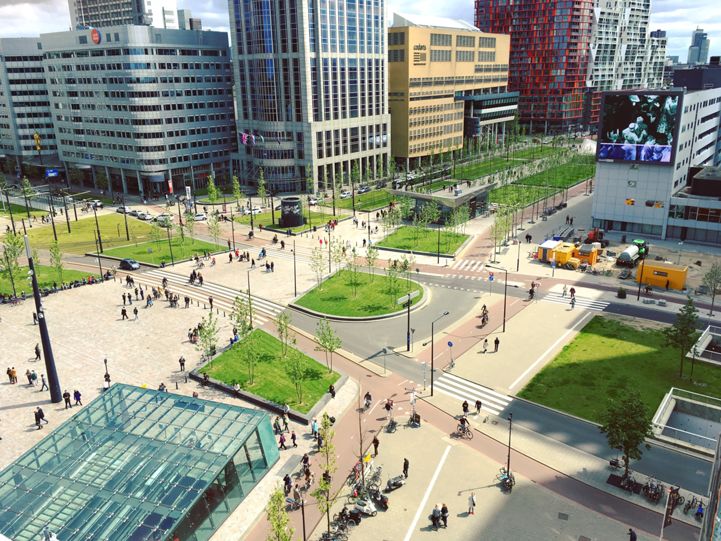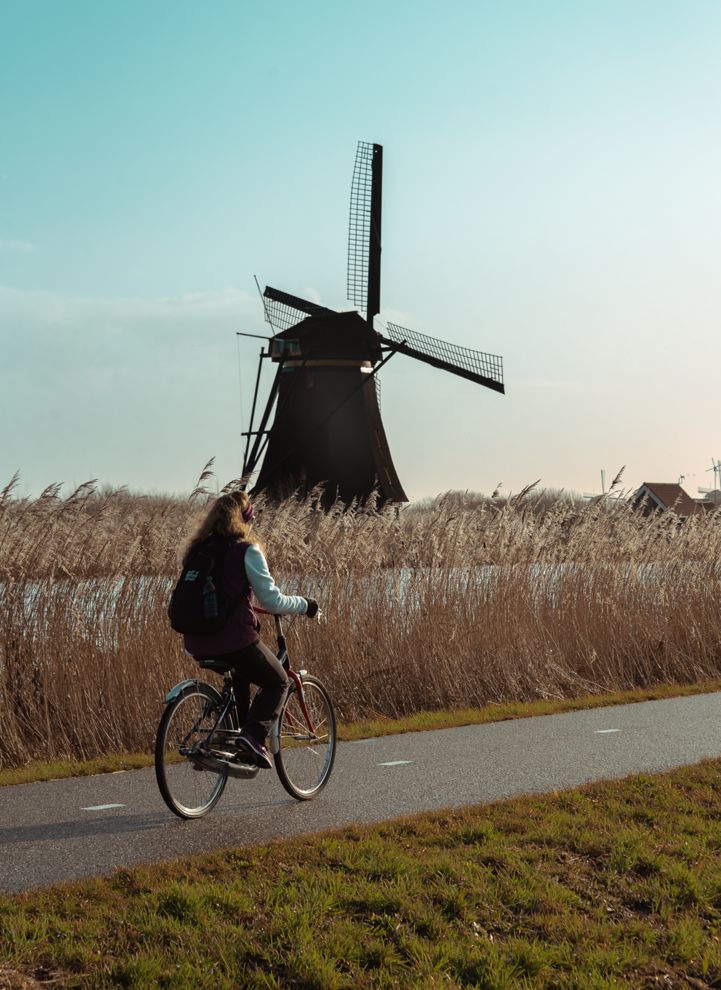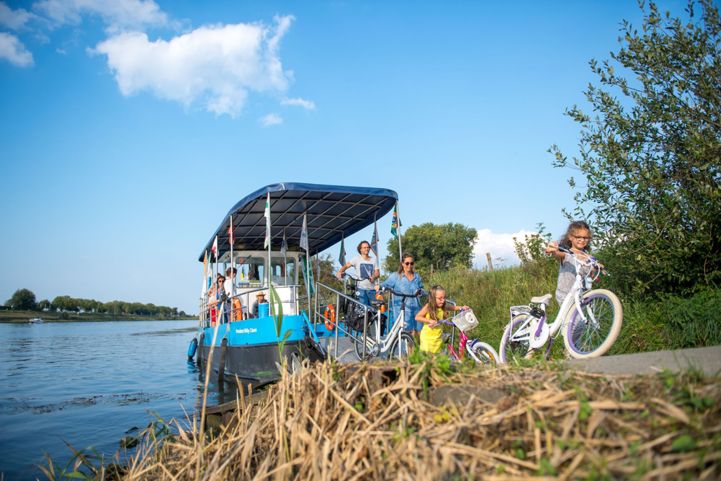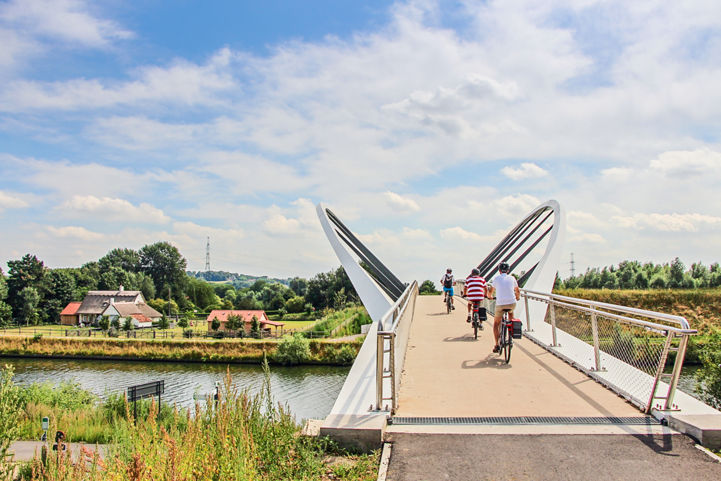EuroVelo 19 - Top cycling infrastructure for a stress-free cycling trip!
We know many cyclists want to feel safe and comfortable when cycling. This does not mean that they do not enjoy the thrill of adventures ‘off the beaten path’, but rather that they appreciate good quality surfaces, safe crossings, consistent signing etc. In this article we are highlighting the excellent cycling infrastructure that you can find along the banks of the River Meuse/Maas when following on EuroVelo 19 - Meuse Cycle Route. We will start our journey in the Netherlands, continue up-river through Belgium and end in France at the source of the Meuse.
The Netherlands
The Dutch section of EuroVelo 19 – Meuse Cycle Route is 480 km long and forms part of the LF Icon routes network, as LF Maasroute. The beautiful route starts/ends in Rotterdam and will take you to the Hoek Van Holland – where the Meuse River flows into the sea – to Maastricht, close to the Belgian border. The Dutch part of the route is divided into 8 sections as shown on this map. Since EuroVelo 19 is well developed and signposted in both directions, it makes it easy to plan and to cycle the opposite direction, from Maastricht to Hoek Van Holland and Rotterdam. You can also purchase the LF-Maasroute cycling guide here.
Our journey starts in the city of Rotterdam, the so called Architecture City of the Netherlands. Reaching the start of the route is quite simple, since Rotterdam’s train station offers good international connections. With more than 600 km of cycle paths, exploring the city is always easy, pleasant and impressive, as you take in the city’s dramatic mix of traditional, modern and futuristic buildings.

There are a vast range of bike services available in Rotterdam. For example, “Vaimoo”, the ebike sharing system, can be really useful, especially as you can take advantage of the many charge points that are available in the city. You can download this guide, proposing two cycle routes options (14 and 17 km) to explore the main sights as well as areas off the beaten track. As the cycling network generally sticks to dedicated bike lanes, you won’t have to worry about your safety and will be able to focus on the remarkable architecture instead.

The highlight of your day will without doubt be get to cycle on the famous and futuristic 800 metre long Erasmusbrug, linking the northern and southern parts of Rotterdam. The 139 metre high suspension bridge is a must to cycle on! It might get windy and rainy at times, but the view is worth it. The Benelux Tunnel, renovated in 2002 to allow cyclists to use it, is another great example of the notable cycling infrastructure available of Rotterdam.
Rotterdam is also known internationally for its major port, which can be visited either by boat, on foot or by bike. To find your way around the harbour area, which covers more than 7,900 ha, you can follow the numbered signs to cycle easily from point to point. Each sign contains an information board as well as a map. One of the points is located near the information centre, there you will find an ANWB Bicycle Service Point, for any small repairs on your bike or simply to charge your ebike. Cycling around the harbour is always a great experience, as you learn more about the history of the area and learn how such a structure works today.
If you feel like visiting somewhere different, you can head to Kinderdijk with a 45 minutes ride from Heerjansdam on EuroVelo 19, or by taking your bike for free in a waterbus from Rotterdam. Here you can admire some picture postcard windmills in a beautiful setting, which form part of a UNESCO World Heritage site.
Belgium
In between Roermond and Maastricht, there is the opportunity to do some crossborder cycling in the Meuse Valley River Park nature reserve. The Meuse river forms the border between the Belgian and Dutch province of Limburg. You can easily cross the border by hopping on one of the ferries that takes you to the other side, because… EuroVelo 19 is signposted on both sides of the river!

This part of the river might just be one of the most beautiful natural stretches of the route, given the river is still wild here. Many parts of the river are straightened for shipping, but in Limburg the river is still free to meander its way through the landscape and offers the most unique patches of astonishing nature. You may just meet some friendly large grazers, Galloway cattle or Konik horses, the self-reliant maintenance team of the Meuse Valley.
The Belgian Limburg section of EuroVelo 19 is one the Iconic Cycle Routes in Flanders, a new network of signposted long distance cycle routes stitching together the best of Flemish scenery along attractive cycle paths and around a central theme. There are also connections with two other Iconic Cycle Routes in Flanders. There’s a crossing with the Hilly Route in Visé and cyclists can start for a ride on the Kempen Route in Maasmechelen. Discover them all here.
From Maastricht, you will find yourself only 7.5 km away from the Belgian border, where you will continue your adventures along the Meuse in the city of Liège, our next stop. This stage is detailed here, where you can download GPX tracks. It is entirely signed with “La Meuse à Vélo” panels and the route is mostly flat and smooth to ride. Nevertheless, you might want to get yourself one of the Ravel cycle guides for cycling this part of EuroVelo 19 – Meuse Cycle Route.
You can also decide to take the train to Liège - Guillemins. You can carry your bike with you in the train but be careful, it is currently not possible at all times of the day. Everything is explained here for Dutch trains and here for Belgian trains.
Walking out of the train station, you will inevitably head to the cycle and pedestrian bridge La Belle Liégoise, a 294 metre long bridge open to public in 2015. The name of the €5.5 million bridge was given as a tribute to Anne Josèphe Théroigne de Méricourt, a major figure in the French Revolution who was originally from this area of Belgium. The bridge directly connects pedestrians and cyclists to the Parc de la Boverie, running at treetop level. Crossing the river on the new and modern bridge, you have the best view on the beautiful Meuse and on the green and modern right bank of the river - the bridge providing a clear view towards the city centre and providing some serenity above the crowded and noisy streets. Once in the city, feel free to go around by bike or on foot. On this page, you will find everything you need to explore the Liège region on the saddle, from cycling tours to bike parking and information about the region’s network of cycle nodes. Don’t forget to buy yourself a traditional Liege waffle on your way!

From Liège, continue upstream to Namur, where you will be impressed by the modern cycling infrastructure in this iconic city – a crossroads of three EuroVelo routes. You will get to cycle or walk across another bridge, L’Enjambée, a 184 metre long construction that was inaugurated and open to the public in 2020. It connects Namur and the neigbbouring town of Jambes over the River Meuse. Pedalling across the bridge, you will be able to enjoy the stunning view of the famous Citadelle overlooking the city and of the typical colourful traditional houses built along the river banks.
Continuing your way towards the French border, the lush Belgian riverside landscapes will bring a smile to your face! From the town of Dinant to the municipality of Givet, you will be cycling on flat cycle routes next to the calm and meandering river. The "La Meuse à Vélo" signs will continue to guide you all the way to the national border, where you will be able to join the Trans-Ardennes Greenway, heading south towards Givet.
France
It is now time to enter the last country of our trip and explore the wonders of the French countryside, with a significant amount located on dedicated cycling infrastructure. The French section is 443 km long, of which 126 km are separated and safe cycle paths and 322 are on low traffic countryside roads sticking close to the river banks. The itinerary is well connected to transportation networks, especially by railway. The TER (regional train) lines usually run several times a day. From Charleville-Mézières to Givet, Sedan to Paris Est and Paris Est to Mulhouse. You can plan your trip here.
Cycling south from Givet, your route will end in Plateau de Langres, where the source of the Meuse River is located. From Saint Mihiel, you can reach the famous and historical area of Verdun, perhaps the country’s most famous First World War battlefield. From the charming town of Dun-Sur-Meuse, you can reach Verdun within a day, via this 42 km long stage. Alternatively, from Samogeux you can ride 19 km to Verdun and travellers will enjoy getting lost in the green and hilly landscapes - this is the second most wooded area of France – on a perfectly safe and segregated cycle path. Once in Verdun, it is worth taking the time to fully explore this historical area, which is filled with beautiful military cemeteries, hills and forests, castles, tiny villages and historical reminders from both World Wars. The local tourist board have some recommended ideas for cycle tours around Verdun.
Then, cycling 38 km from Verdun to Saint-Mihiel, and 23 km from Saint-Mihiel to Commercy, you will be able to join the much appreciated separated cycle path to find yourself in the heart of the Parc Naturel Régional de Lorraine and its rich ecosystem, from humid forests to swamps and home to a wide variety of fauna and flora.

For more information on the route we advise you to read this article inspiring you with tips to plan successful cycle trips on EuroVelo 19 – Meuse Cycle Route.
If you want to know more about some other best practices in cycle tourism from across Europe in the following categories: infrastructure, advanced services, cycle tourism in natural areas, promotion, financing, planning & management and intermodality, check out this article, in this article EuroVelo 19 is pictured as a best practice example.
Author: Lauriane Irien